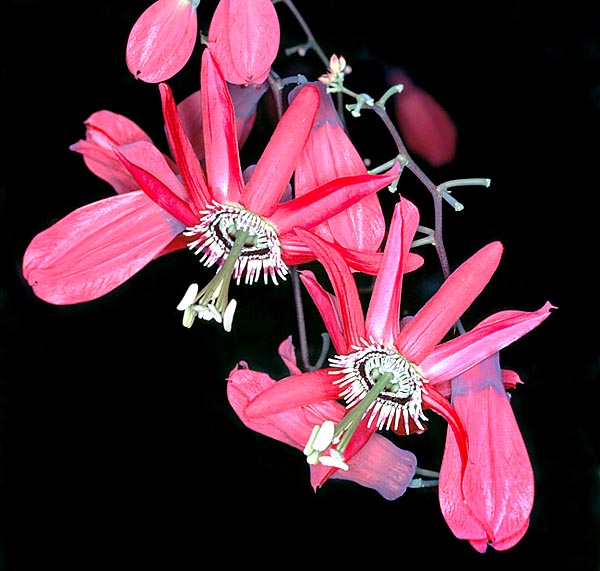Family : Passifloraceae

Text © Pietro Puccio

English translation by Mario Beltramini

Passiflora racemosa has drooping 50 cm inflorescences with 10-12 cm corollas © Giuseppe Mazza
The name of the genus is the combination of the Latin terms “passio, -onis” = passion and “flos, -oris” = flower, with reference to the structure of the flower where the first Spanish missionaries saw the instruments of the Passion of Christ; the Latin name of the species “racemosa” = racemose, clusterlike, refers to the shape of the inflorescence.
Common names: red passionflower (English); passiflore rouge (French); maracujà-do-principe, maracujà-mirim (Portuguese-Brazil); Rote Passionsblume (German).
The Passiflora racemosa Brot. (1817) is an evergreen perennial climbing species which anchors to the supports by means of tendrils produced at the axil of the leaves; it presents woody stems, greyish and almost cylindrical below, herbaceous, glabrous and filiform above, up to about 10 m long.
The leaves, on a 2-4 cm long petiole usually provided with two pairs of nectariferous glands, are alternate, ovate in the young plants, usually tri-lobed in the adult ones, coriaceous, of intense glossy green colour, 6-10 cm long with ovate or oblong lobes and entire margins; the stipules (appendages at the base of the petiole having the task to protect the leaf during the first stages of its development) are ovate with entire margin, 1-1,5 cm long and about 0,8 cm broad.
Axillary racemose inflorescences, pendulous, up to about 50 cm long, produced also in the older woody part having no leaves, carrying numerous flowers of 10-12 cm of diameter, single or in pair, opening in succession, of coral red colour. Corolla with 5 oblong sepals, about 4 cm long and 1 cm broad, keeled, 5 oblong petals, slightly shorter than the sepals, and crown with three series of filaments, those of the outer part, about 0,5 cm long, are usually white or purple with white extremity; the flowers are self-sterile, for the crossed fecundation it is therefore necessary the presence of another plant not gotten by vegetative way from the same, they may however be fecundated by the pollen of another compatible species, like that of the Passiflora caerulea.
The fruit is an about 6 cm long oblong berry of 2-2,5 cm of diameter of pale green colour when ripe containing several obovate seeds about 0,5 cm long; the pulp surrounding the seeds is edible. It reproduces by seed, if necessary scarified and kept in water for two days in order to favour the germination, in sandy loam rich of organic substance, kept humid at the temperature of 22-24 °C, with variable germination times, even long, but usually and easily recourse is done to the semi-woody cutting in summer and to the layering in spring.
Species among the most ornamental of the genus Passiflora, vigorous, fast-growing, and with the flowering going on for most of the year, which has originated several hybrids. Cultivable in the tropical and subtropical climates and marginally in the warm temperate ones, where temperatures around the 0°C are short-lasting exceptions; it requires full sun or a slight shade and fertile and well drained soils, from slightly acidic to slightly alkaline, with regular and abundant waterings in summer, keeping the soil slightly humid in winter. Where the climate does not allow the continuous permanence in open air, it can be cultivated in pot in sandy loam, draining, rich of organic substance, in order to be sheltered in winter in protected, luminous location, with temperatures preferably not under the 14 °C.
Synonyms: Passiflora princeps Lodd. (1818).
→ To appreciate the biodiversity within PASSIFLORACEAE family please click here.
